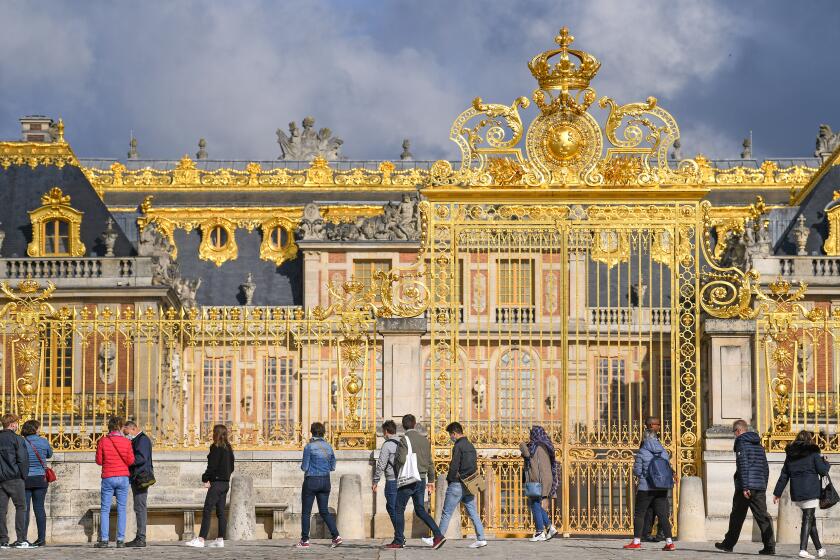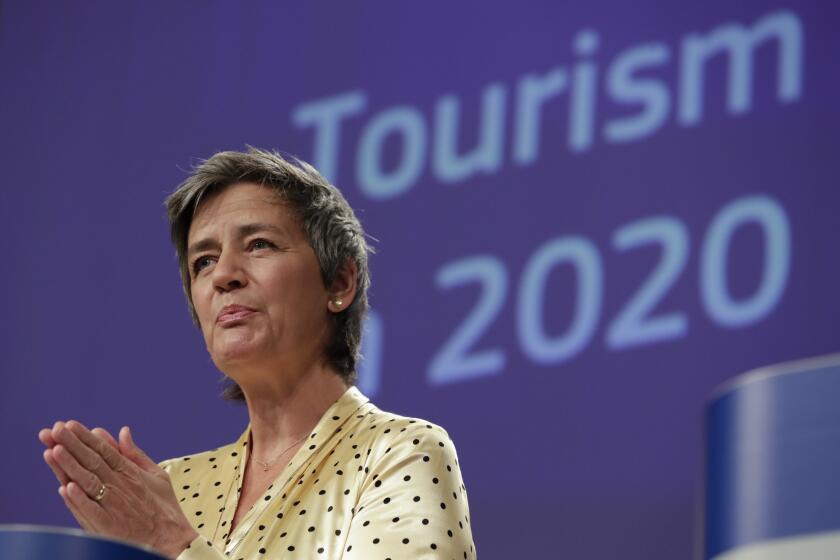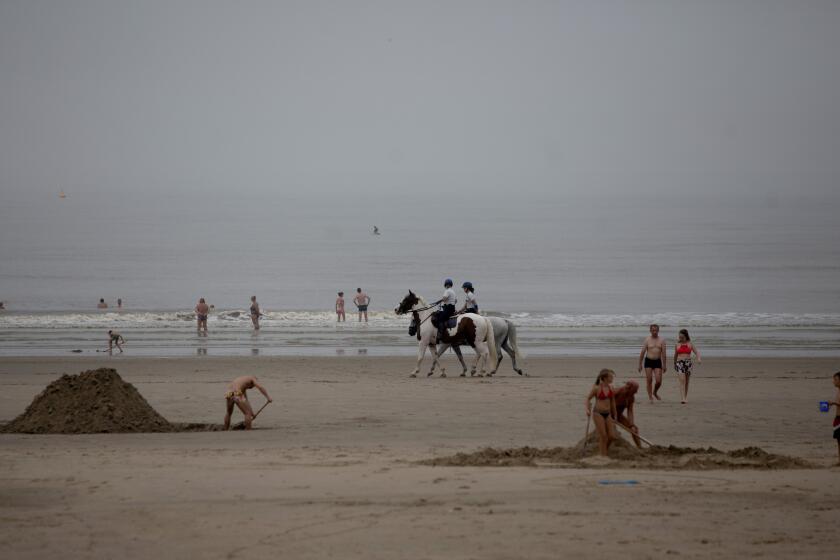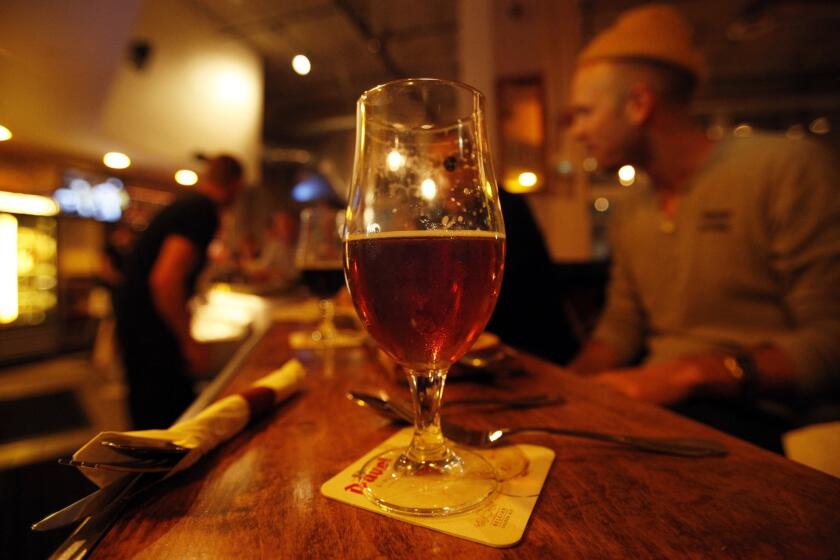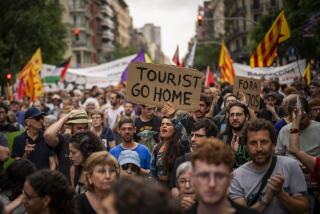Coronavirus turns this summer into Europe’s leanest tourist season
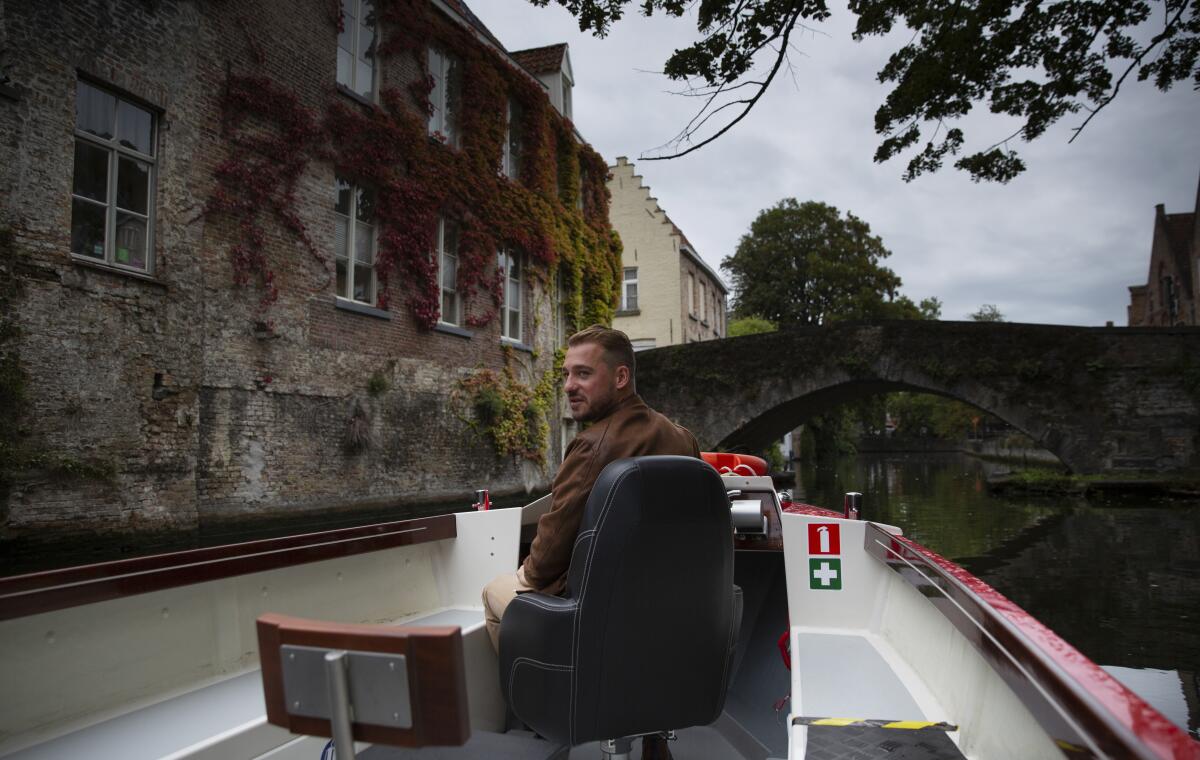
- Share via
BRUGES, Belgium — Mayor Dirk De fauw first realized something was desperately wrong with European tourism when, on a brisk March morning, he crossed the Burg square in front of Bruges’ photogenic Gothic City Hall and there was nothing but silence.
“There are always people. Always,” De fauw said.
But that morning? “Nothing. Nobody is on that large square” in Belgium at the heart of one of Europe’s most picturesque cities, he said.
Six months later, as Europe’s leanest tourist summer season in recent history is starting to draw to a close, COVID-19 has yet to loosen its suffocating grip on leisure travel on the continent.
If anything, the pandemic might tighten it over the coming months, with tourism losses piling up in the tens of billions of dollars across the 27-nation European Union and the continent’s vaunted government support systems under increasing strain to prop up the sector.
Losses during the first half of 2020 for hotels, restaurants, tour operators, long-distance train services and airlines were roughly 85% to 90%, said the European Commission, the EU’s executive arm. No country has been exempt in a vast area stretching from the beaches in Greece to the trattorias in Rome to the museums of Paris.
Foreign visitors are vital to many European economies, which are clamoring — and competing — for tourists to return as coronavirus lockdowns ease.
Even now, with lockdowns eased in many nations, “bookings for September and October remain abnormally low,” the commission said. The grim outlook scuttles hopes that a brief uptick in business in July would be a harbinger of a stronger, more durable recovery.
Instead, the summer brought fresh spikes in COVID-19 infections in countries such as Spain and France, new restrictive measures and coronavirus-warning color codes that spelled disaster for local tourism when they turned red.
This has left the industry relying on hope more than anything else. That was evident on a late summer’s day in Bruges, when usually throngs of American, Asian and European tourists stroll along the cobblestone streets below the city’s gabled houses, bringing annual visits to more than 8 million in the city of 110,000.
“The swans have it all to themselves,” said Michiel Michielsens as he slowed his boat behind a group of the birds on a city canal. On a normal day — not like the one when he had 114 customers instead of 1,200 — tourists would rule the waters. Now a boat could be seen showing a single couple around instead of its normal load of 40 people.
Concern is mounting that border restrictions introduced to stop the spread of the coronavirus could end free travel across Europe permanently.
For tourists who can live with wearing masks for hours, there are some advantages. In Bruges, it extends to the city’s famed museums, where the medieval Flemish Primitives take center stage. Instead of craning over other tourists holding up their smartphones to snap photos, any visitor could now be alone for minutes on end to study in detail one of Jan Van Eyck’s most famous pictures,“Our Lady With the Child Jesus, St. George, St. Donaas and canon van der Paele.”
All this is bittersweet to museum officials, though. Across Europe, just about all had to close for months earlier this year, and the outlook is bleak.
Attendance has now slumped to a quarter of what it was in 2019 at Bruges museums. During the uptick in July, “we had 50%,” said Jonathan Nowakowski, the business director of Bruges Museums.
“So it’s declining gradually. Every month we see the numbers declining,” Nowakowski said. “I can tell you that we’re looking at losses of 3.4 to 4 million euros this year” — about $4 million to $4.7 million — despite high expectations in a Van Eyck commemorative year with special exhibits.
The coronavirus and a heat wave are weighing heavily on Belgium, where people are living under a new series of health restrictions.
“We had thought we would have had huge numbers of visitors,” he said.
It all quickly trickles down to hotels, restaurants, shops and the survival of families. For those who own the building they’re in, it’s more manageable than for those who rent. With reservations down for the next months, some hotels will simply shut, knowing the costs will never match the puny revenue. Others are offering their low winter rates this summer to entice visitors.
A great many have put staff on temporary unemployment, acknowledging that government aid has been a help. But they fear that that will be whittled down soon, despite the 750-billion-euro ($885-billion) recovery fund that the EU recently agreed to set up.
“In the next few months, we will see a lot of places that will go bankrupt. A lot of people will be unemployed,” said Luc Broes, co-owner of the hotel-restaurant Duc de Bourgogne, which overlooks a canal in Bruges.
Breaking News
Get breaking news, investigations, analysis and more signature journalism from the Los Angeles Times in your inbox.
You may occasionally receive promotional content from the Los Angeles Times.
Social protections, he said, only go so far.
“We also have to pay our rent for the building. We also have to pay all the staff. We have to pay the insurances. ... In the moment we can’t pay anymore, we will go bankrupt as well,” Broes said.
Despite the 19th-century novel “Bruges-La-Morte” (“Bruges, the Dead City”) that turned the city into a metaphor of melancholy and decay, there is a steadfast conviction among some that people can turn this around — that tourism will survive. A special EU summit is scheduled for October to examine how to reinvigorate and reform tourism.
Unsure how long the pandemic will last, Bruges has decided to forgo any blockbuster exhibits. Instead, it will focus on local artists, including a photographer tasked with showing the solitude that COVID-19 has brought to the city.
Bruges, Belgium, will soon have an underground beer pipeline. And it’s exactly what you think it is.
The question of whether there will be more lockdowns, nationwide restrictions or limits on international travel still haunts everyone. The European Union has seen nearly 141,000 confirmed coronavirus-related deaths, and Europe as a whole — including non-EU members Britain and Russia — has seen more than 212,000, according to a tally by Johns Hopkins University.
Renowned chocolatier Dominique Persoone relied on a big local fan base to help him survive without the big cruise-ship crowds who come and buy his chocolates from his shop by the cathedral.
“The hardest thing is that you don’t know what the future will bring. We don’t know how it’s going to be in September, October, when the real chocolate season starts. Then it’s Halloween, Santa Claus, Christmas.”
Winter and more uncertainty beckon.
“We thought we were safe and we had a wonderful life, and now this is happening,” Persoone said.
More to Read
Sign up for Essential California
The most important California stories and recommendations in your inbox every morning.
You may occasionally receive promotional content from the Los Angeles Times.
